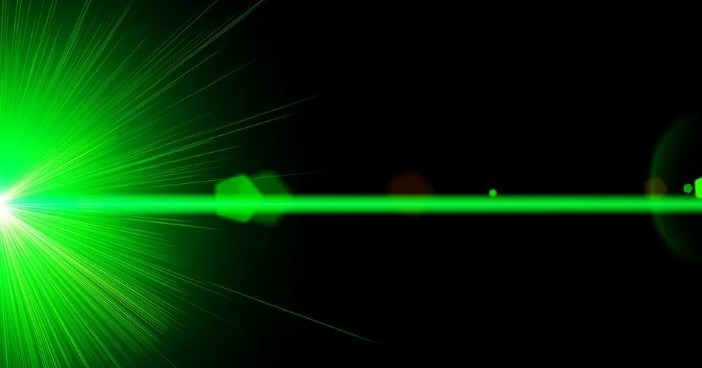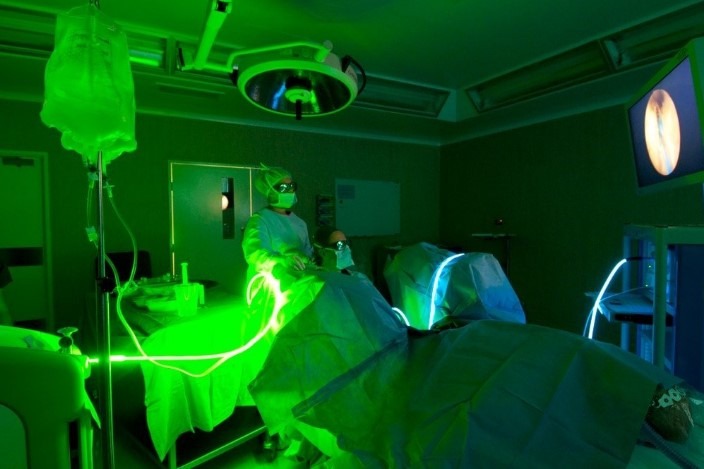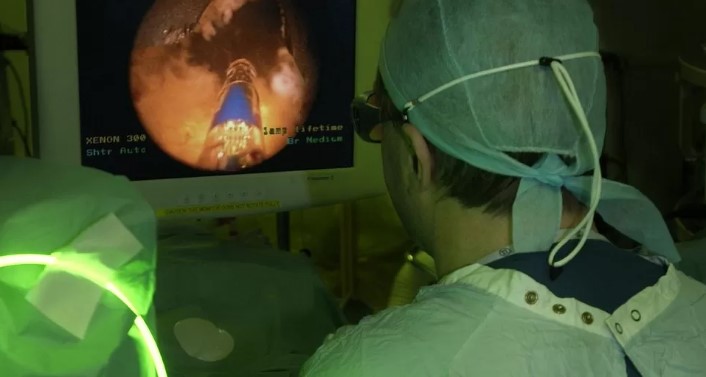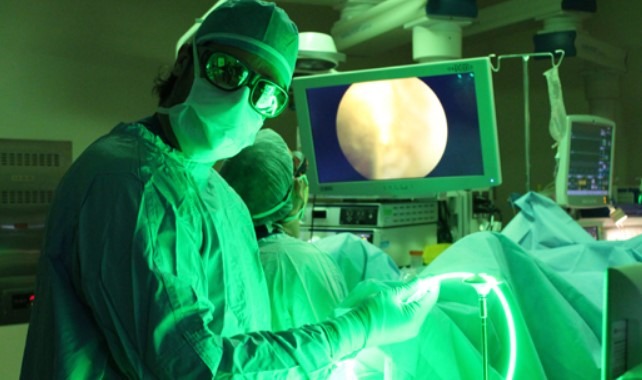Health
Pros and Cons of Green Light Laser Surgery: A Comprehensive Guide

The world of medical advancements is constantly evolving, and green light laser surgery is no exception. This minimally invasive surgical technique is a popular treatment option for benign prostatic hyperplasia (BPH), a common prostate condition affecting men. In this comprehensive guide, we’ll delve into the pros and cons of green light laser surgery, exploring its effectiveness, potential complications, and how it compares to other BPH treatment options. Armed with this knowledge, you can make an informed decision about whether this procedure is right for you.
Table of Contents
How Effective is Green Light Laser Surgery for Treating BPH?

Green light laser surgery, also known as photoselective vaporization of the prostate (PVP), is a highly effective treatment for BPH. This innovative procedure uses a high-powered laser to vaporize excess prostate tissue, relieving pressure on the urethra and improving urinary flow. Clinical studies have shown that green light laser surgery can significantly improve urinary symptoms, with success rates of over 80%. Moreover, the procedure’s minimally invasive nature means that it often results in shorter hospital stays and quicker recovery times compared to traditional BPH treatments, such as transurethral resection of the prostate (TURP).
What are the Potential Complications of Green Light Laser Surgery?
While green light laser surgery is generally considered safe and effective, it’s not without its potential complications. Some risks associated with the procedure include:
- Bleeding: Although the risk is low, some patients may experience minor bleeding after surgery.
- Urinary tract infections: A small percentage of patients may develop a urinary tract infection following the procedure.
- Retrograde ejaculation: This is a condition where semen flows backward into the bladder during ejaculation. It’s a potential side effect of many BPH treatments, including green light laser surgery.
- Temporary urinary incontinence: Some patients may experience temporary difficulty controlling their urine after the procedure.
It’s important to discuss these potential risks with your doctor to fully understand the implications of undergoing green light laser surgery.
How Does Green Light Laser Surgery Compare to Other BPH Treatment Options?

Green light laser surgery has emerged as a popular alternative to traditional BPH treatments, such as TURP and prostatectomy. Key advantages of this minimally invasive technique include:
- Shorter hospital stays: Green light laser surgery is often performed on an outpatient basis, meaning patients can return home the same day.
- Reduced blood loss: The procedure’s laser technology minimizes bleeding, making it a safer option for patients with blood clotting disorders or those taking blood thinners.
- Quicker recovery: Patients typically experience a faster return to normal activities compared to more invasive surgical options.
However, it’s worth noting that green light laser surgery may not be suitable for all BPH patients, particularly those with very large prostates or other complicating factors. Your doctor can help you determine the most appropriate treatment option for your specific case.
What is the Recovery Process Like After Green Light Laser Surgery?
Recovery from green light laser surgery is generally faster and more comfortable than traditional BPH treatments. Patients can expect to experience some discomfort and mild swelling in the days following the procedure. Temporary urinary incontinence or urgency may also occur, but these symptoms usually subside within a few weeks. Most patients can resume their normal activities within a week of surgery, and improvements in urinary symptoms are typically noticeable within days of the procedure.
How Long Does It Take to See Results After Green Light Laser Surgery?
Patients often report significant improvements in urinary flow and symptoms within days of undergoing green light laser surgery. However, it’s important to remember that individual results may vary, and some patients may require additional time to fully recover and experience the full benefits of the procedure.
What is the Success Rate of Green Light Laser Surgery?
The success rate of green light laser surgery is impressive, with studies reporting an overall success rate of over 80%. This means that the majority of patients experience significant improvements in their urinary symptoms following the procedure. However, it’s essential to note that individual outcomes can vary, and some patients may require additional treatments or follow-up procedures to maintain optimal results.
Are There Any Lifestyle Changes I Need to Make After Green Light Laser Surgery?
Following green light laser surgery, it’s important to adhere to any post-operative instructions provided by your healthcare team. This may include avoiding heavy lifting, strenuous exercise, and sexual activity for a specified period of time. Additionally, maintaining a healthy lifestyle by eating a balanced diet, staying hydrated, and getting regular exercise can help support your prostate health and overall well-being.
How Does Green Light Laser Surgery Work to Treat BPH?
Green light laser surgery utilizes a high-powered laser to vaporize excess prostate tissue that is causing urinary obstruction. The procedure involves the insertion of a thin fiber optic cable through the urethra, which delivers precise laser energy to the targeted tissue. The laser’s green light is selectively absorbed by the blood vessels within the prostate, effectively vaporizing the obstructive tissue without causing damage to the surrounding area. This results in improved urinary flow and relief from BPH symptoms.
Who is a Good Candidate for Green Light Laser Surgery?

Green light laser surgery is an excellent treatment option for many patients with BPH. Ideal candidates for the procedure include:
- Men experiencing moderate to severe urinary symptoms due to BPH
- Patients who have not responded well to medication or other conservative treatments
- Men who are not suitable candidates for more invasive BPH treatments, such as TURP or prostatectomy
However, green light laser surgery may not be suitable for all patients, particularly those with very large prostates or other complicating factors. Your doctor can help determine if this procedure is right for you based on your individual circumstances and medical history.
Can Green Light Laser Surgery Be Performed on an Outpatient Basis?
Yes, green light laser surgery can often be performed on an outpatient basis, meaning patients can return home the same day as their procedure. This is one of the key advantages of this minimally invasive technique, as it typically results in shorter hospital stays and faster recovery times compared to traditional BPH treatments. However, individual circumstances and hospital policies may vary, so it’s essential to discuss your specific case with your healthcare provider.
Frequently Asked Questions
Is green light laser surgery painful?
Green light laser surgery is generally performed under general or spinal anesthesia, so patients should not experience pain during the procedure. Some discomfort and mild swelling may occur in the days following surgery, but this can usually be managed with over-the-counter pain relievers and anti-inflammatory medications.
Can green light laser surgery be repeated if BPH symptoms return?
In some cases, BPH symptoms may return over time, necessitating further treatment. Green light laser surgery can often be repeated if necessary, although the need for additional procedures is relatively low, with success rates of over 80%. If BPH symptoms do recur, your doctor will discuss the most appropriate treatment options based on your individual circumstances.
Does green light laser surgery affect sexual function?
Green light laser surgery has a lower risk of sexual side effects compared to more invasive BPH treatments, such as TURP or prostatectomy. While retrograde ejaculation can be a potential side effect, most patients do not experience significant changes in sexual function following the procedure.
Also Read: Pros and Cons of Dry Needling: Comprehensive Guide to Trigger Point Therapy
Conclusion
In conclusion, green light laser surgery is a highly effective and minimally invasive treatment option for many patients with BPH. Its numerous advantages, including shorter hospital stays, reduced blood loss, and quicker recovery times, make it an appealing choice for those seeking relief from bothersome urinary symptoms. However, it’s essential to carefully weigh the pros and cons of this procedure, considering potential complications and individual circumstances before deciding if green light laser surgery is the right treatment for you.
By thoroughly discussing your options with a qualified urologist, you can make an informed decision about your prostate health and choose the most appropriate course of action to address your BPH symptoms. Remember, maintaining open communication with your healthcare team is crucial in ensuring a successful treatment outcome and a smoother recovery process.
Green light laser surgery is undoubtedly a groundbreaking advancement in the field of urology, offering a safe and effective solution for many patients with BPH. As medical technology continues to evolve, we can expect even more innovative treatments and improved outcomes for those suffering from this common prostate condition. With the right information and expert guidance, you can confidently choose the best treatment path for your unique needs, ultimately leading to a better quality of life and long-term prostate health.

-

 Health5 years ago
Health5 years agoAdvantages and Disadvantages of Milk
-

 Tech4 years ago
Tech4 years ago6 Tips to Improving E-Commerce Websites
-

 Home5 years ago
Home5 years agoAdvantages and Disadvantages of Village Life in Points
-

 Travel5 years ago
Travel5 years agoAdvantages and Disadvantage of Travelling
-

 Sports3 years ago
Sports3 years agoThe benefits of playing an online live casino
-

 Tech5 years ago
Tech5 years ago10+ Advantages and Disadvantages of Mobile Phones in Points
-

 Tech5 years ago
Tech5 years agoEssay on Advantages and Disadvantages of Offline Shopping
-

 Tech5 years ago
Tech5 years ago8+ Advantages and Disadvantages of Motorcycle |Having Bike